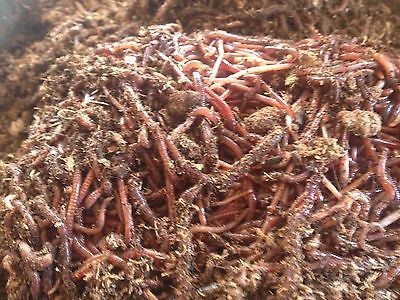Top-rated red worms: Composting made easy
Change Your Garden With Red Wigglers: Idea
Red wigglers are not simply a curiosity for garden compost enthusiasts; they are critical representatives of improvement for any kind of yard. By developing a standard worm container and recognizing the nutritional needs of these remarkable animals, garden enthusiasts can significantly boost dirt high quality and plant wellness. The procedure of transforming natural waste into rich, productive spreadings is both uncomplicated and satisfying. The true capacity of red wigglers goes past mere composting. Discovering the subtleties of their treatment and the varied applications of their byproducts can unlock even greater advantages for your gardening endeavors.

Advantages of Red Wigglers
Red wigglers, medically referred to as Eisenia fetida, are often hailed as nature's composting champs. These amazing worms offer a number of essential benefits that can considerably enhance garden health and productivity. They are reliable decomposers, breaking down organic material such as cooking area scraps and lawn waste into nutrient-rich vermicompost (red worms). This natural plant food enriches the soil, advertising healthy plant growth and improving dirt structure.

An additional noteworthy advantage of red wigglers is their ability to minimize waste. By composting natural products that would certainly otherwise contribute to land fill waste, they play an important duty in lasting gardening techniques. Lastly, integrating these worms into your gardening routine can lead to increased returns, healthier plants, and an extra vibrant garden environment, making them invaluable allies for gardeners looking for to boost their eco-friendly footprint.
Setting Up a Worm Bin
Developing a worm bin is a necessary step for anybody aiming to harness the advantages of red wigglers in their gardening initiatives. An appropriate worm bin can be made from different products, consisting of plastic containers, wood cages, or readily offered worm bins. The very first factor to consider is size; a container that is at least 2 feet broad, 3 feet long, and 1 foot deep is usually ideal for a little to tool variety of worms.
Next, make sure appropriate drain and air flow. Pierce openings in the bottom for excess dampness to leave and in the sides for airflow. It is very important to create a bed linens layer, using materials such as shredded newspaper, cardboard, or coconut coir to give a comfortable atmosphere for the worms. The bed linens ought to be damp yet not soggy, resembling a moist sponge.
Area the container in a place that maintains a constant temperature level, preferably in between 55 ° F and 77 ° F. Avoid straight sunlight or severe cool, as these problems can harm the worms. As soon as the container is established, permit the bed linens to resolve for a couple of days prior to presenting the red wigglers, guaranteeing they have a growing environment in which to prosper.
Feeding Your Red Wigglers
As soon as the worm container is established and the red wigglers are introduced, proper feeding becomes key to preserving a healthy and balanced worm populace. Red wigglers prosper on a diverse diet plan, primarily including cooking area scraps and organic materials. Suitable foods include veggie peels, fruit scraps, coffee grounds, and crushed eggshells. It is critical to avoid feeding them meat, milk, or oily foods, as these can develop undesirable odors and attract bugs.
When presenting food, cut the scraps into smaller items to promote quicker consumption. Furthermore, bury the food beneath a layer of bed linen product to avoid fruit flies and other problems. Monitor the feeding regularity; a general guideline is to give food every 1-2 weeks, depending upon the variety of worms and the quantity of food waste produced.

Gathering Worm Spreadings
Just how can you inform when it's time to collect worm spreadings from your bin? The readiness of worm spreadings is shown by a couple of crucial indications.
Another sign is the decrease in worm task; as the spreadings gather, worms tend to migrate towards fresher food sources. If you discover a decline in worm movement and the presence of castings at the base of the container, it's a clear signal that harvesting is due.
To collect, delicately dig the castings, taking care to minimize disturbance to the worms. A prominent method involves separating the spreadings utilizing light; worms tend to delve away from the light, permitting you to gather the castings a lot more conveniently.
Gathering frequently, about every three to six months, makes sure a consistent supply of this nutrient-rich change for your horticulture endeavors. Remember, the top quality of your spreadings straight impacts the health of your plants.
Using Castings in Your Garden
(eisenia fetida worms for sale)Using worm spreadings in your yard can considerably boost dirt health and wellness and plant development - red worms. These nutrient-rich organic fertilizers give necessary macro and trace elements, boosting the general fertility of your dirt. By integrating worm spreadings into your yard beds, you can advertise beneficial microbial task, which assists in nutrient schedule and enhances dirt framework
To utilize worm spreadings successfully, mix them right into the leading few inches of dirt prior to planting. You can develop a nutrient-dense liquid fertilizer by steeping worm castings in water for a week, after that using the resulting "worm tea" straight to your plants.
Worm castings also improve moisture retention within the soil, minimizing the requirement for constant watering. Consistently incorporating worm castings right into your gardening routine can lead to durable plant growth, boosted returns, and a total healthier garden environment.
Final Thought
By establishing a worm container, supplying suitable food, and on a regular basis gathering nutrient-rich spreadings, gardeners can foster a sustainable community. The usage of worm castings and "worm tea" further contributes to moisture retention and nutrient accessibility in the dirt.